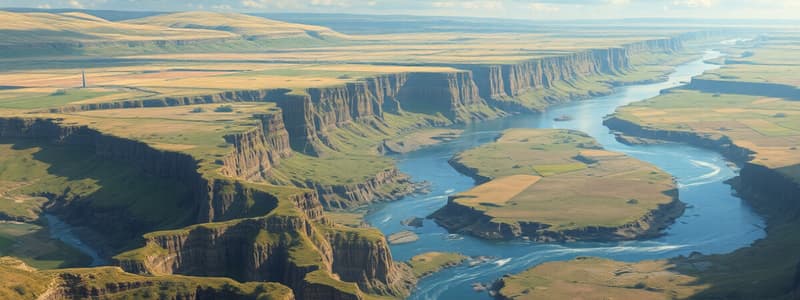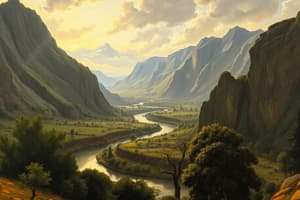Podcast
Questions and Answers
In the upper course of the River Tees, which process is most dominant in shaping the landscape?
In the upper course of the River Tees, which process is most dominant in shaping the landscape?
- Deposition of sediments, leading to floodplain development.
- Oxbow lake formation, indicating a mature river system.
- Meander formation and lateral migration.
- Erosion due to steep gradients and high water velocity. (correct)
What is the primary reason for the formation of waterfalls in the upper course of a river like the River Tees?
What is the primary reason for the formation of waterfalls in the upper course of a river like the River Tees?
- Differential erosion of alternating resistant and less resistant rock layers. (correct)
- Uniform resistance of rock layers to erosion.
- Deposition of sediment creating a barrier.
- Tectonic uplift causing a sudden change in elevation.
How do interlocking spurs form within a V-shaped valley?
How do interlocking spurs form within a V-shaped valley?
- The river erodes the path of least resistance around resistant bands of rock. (correct)
- Tectonic activity causing the valley to widen.
- Deposition of sediment on the valley floor.
- Mass movement of soil and rock from the valley sides.
Which of the following best describes the process of meander formation in the middle and lower courses of a river?
Which of the following best describes the process of meander formation in the middle and lower courses of a river?
What is the most likely result of a meander neck being eroded through?
What is the most likely result of a meander neck being eroded through?
Which of these human activities is a non-point source of water pollution?
Which of these human activities is a non-point source of water pollution?
What is 'eutrophication', a common effect of water pollution?
What is 'eutrophication', a common effect of water pollution?
What is the most effective strategy for reducing agricultural runoff into rivers?
What is the most effective strategy for reducing agricultural runoff into rivers?
What is the purpose of 'chlorination' in water treatment?
What is the purpose of 'chlorination' in water treatment?
Which of the following factors contributes to water scarcity?
Which of the following factors contributes to water scarcity?
Which sustainable water management practice involves collecting rainwater for later use?
Which sustainable water management practice involves collecting rainwater for later use?
What characterizes the middle course of a river like the River Tees?
What characterizes the middle course of a river like the River Tees?
How does industrial discharge typically lead to water pollution?
How does industrial discharge typically lead to water pollution?
Which water treatment process is primarily responsible for removing solid particles?
Which water treatment process is primarily responsible for removing solid particles?
Why is sustainable water management essential in the face of climate change for the River Tees?
Why is sustainable water management essential in the face of climate change for the River Tees?
What is the role of mass movement and weathring in the formation of V-shaped values?
What is the role of mass movement and weathring in the formation of V-shaped values?
How can improved sewage treatment contribute to managing water pollution?
How can improved sewage treatment contribute to managing water pollution?
What happens to the overhanging rock in waterfalls?
What happens to the overhanging rock in waterfalls?
What is one reason for challenges in water supply?
What is one reason for challenges in water supply?
What increases because of efficient irrigation techniques?
What increases because of efficient irrigation techniques?
Flashcards
River Tees Location
River Tees Location
Located in Northern England, rising in the Pennine Hills and flowing east into the North Sea.
River Tees Upper Course
River Tees Upper Course
Steep gradients leading to vertical erosion.
River Tees Middle Course
River Tees Middle Course
Gentler slope; both erosion and deposition occur.
River Tees Lower Course
River Tees Lower Course
Signup and view all the flashcards
Waterfall Formation
Waterfall Formation
Signup and view all the flashcards
High Force
High Force
Signup and view all the flashcards
V-Shaped Valleys
V-Shaped Valleys
Signup and view all the flashcards
Meanders
Meanders
Signup and view all the flashcards
River Cliff
River Cliff
Signup and view all the flashcards
Slip-Off Slope
Slip-Off Slope
Signup and view all the flashcards
Oxbow Lake Formation
Oxbow Lake Formation
Signup and view all the flashcards
Water Pollution
Water Pollution
Signup and view all the flashcards
Industrial Discharge
Industrial Discharge
Signup and view all the flashcards
Agricultural Runoff
Agricultural Runoff
Signup and view all the flashcards
Sewage Pollution
Sewage Pollution
Signup and view all the flashcards
Urban Runoff
Urban Runoff
Signup and view all the flashcards
Water Supply
Water Supply
Signup and view all the flashcards
Sources of Water Supply
Sources of Water Supply
Signup and view all the flashcards
Water Treatment Process
Water Treatment Process
Signup and view all the flashcards
Challenges in Water Supply
Challenges in Water Supply
Signup and view all the flashcards
Study Notes
- Rivers shape landforms and influence human activities on Earth.
- The River Tees in the UK provides a case study for understanding river processes and landforms.
River Tees: A Case Study
- The River Tees rises in the Pennine Hills and flows eastward to the North Sea, in the north of England.
- Its course demonstrates various fluvial landforms and processes.
- The upper course has steep gradients and is dominated by erosion.
- The middle course has a gentler slope, with both erosion and deposition.
- The lower course features a very gentle slope and is dominated by deposition.
Waterfalls and V-Shaped Valleys
- Waterfalls form in a river's upper course, where resistant rock overlays less resistant rock.
- Erosion of the softer rock causes the harder rock to collapse, and the waterfall retreats upstream.
- High Force on the River Tees exhibits these processes.
V-Shaped Valleys
- V-shaped valleys are typical of a river's upper course.
- Vertical erosion forms these valleys as the river cuts down into the landscape.
- Weathering and mass movement shape the steep valley sides.
- Interlocking spurs are characteristic features within V-shaped valleys, formed as the river erodes a path of least resistance.
Meanders
- Meanders are bends in a river, found mainly in the middle and lower courses.
- Erosion and deposition create meanders.
- Water flows faster on the outside of a bend, creating lateral erosion and a river cliff.
- Slower water flow on the inside of the bend results in deposition and a slip-off slope (or point bar).
- Over time, the meander migrates across the floodplain.
- Oxbow lakes can form when a meander neck erodes, cutting off the meander from the main channel.
Water Pollution
- Water pollution is the contamination of water bodies like rivers, lakes, and groundwater.
- Industrial discharge of chemical waste is a source of water pollution.
- Agricultural runoff of fertilizers and pesticides pollutes water.
- Sewage, either untreated or poorly treated, is a source of water pollution.
- Urban runoff containing pollutants from roads contributes to water pollution.
- Water pollution harms aquatic life and poses risks to human health.
- Eutrophication (excessive nutrient enrichment) can result from water pollution.
- Stricter regulations on industrial discharge are used as a management strategy.
- Sustainable agricultural practices help manage water pollution.
- Improved sewage treatment is a management strategy.
- Public awareness and education are key to managing water pollution.
Water Supply
- Water supply is the provision of water for human needs, like drinking, sanitation, agriculture, and industry.
- Rivers and lakes are sources of water supply.
- Groundwater aquifers provide water.
- Reservoirs store water for supply.
- Desalination plants are water supply sources.
- Water treatment is essential for safe human consumption.
- Filtration removes solid particles during water treatment.
- Sedimentation allows heavier particles to settle.
- Chlorination disinfects water.
- Water distribution uses a network of pipes and pumping stations.
- Water scarcity occurs due to climate change and population growth.
- Aging infrastructure leads to leaks and inefficiencies.
- Water pollution reduces the availability of clean water.
- Water conservation measures support sustainable water management.
- Efficient irrigation techniques promote sustainable water management.
- Rainwater harvesting is a sustainable water management practice.
- Water reuse and recycling are an important part of sustainable water management.
Studying That Suits You
Use AI to generate personalized quizzes and flashcards to suit your learning preferences.




